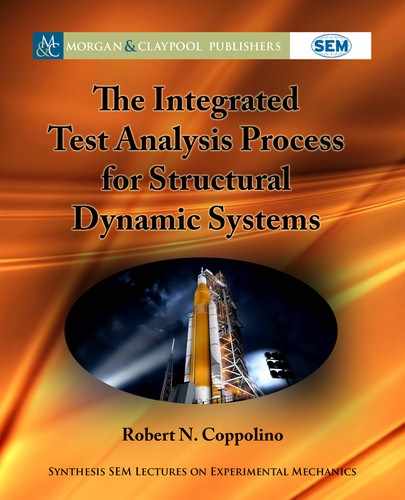
8 2. DEFINITION OF TEST ARTICLE FINITE ELEMENT MODELS
Free vibration analysis of a matrix structural system is typically performed on an undamped
system, for which the modes or real eigenvectors satisfy a mass weighted orthogonality relation-
ship. Free vibration analysis of a damped structural system is rarely performed due to difficulties
associated with theoretical damping matrices that do not relate to empirical modal damping.
An alternative to the explicit damping matrix, namely a complex structural damping constant,
is often employed in aeroelastic analysis [14]. e more widely used description of damping is
based on critical damping ratio factors assigned to a truncated set of undamped system modes.
2.1.2 ECONOMY IN NATURE AND BASIC VARIATIONAL
FORMULATIONS
Philosophers of antiquity, before the advent of modern science initiated by Newton (1686),
believed that nature operated in accordance with a rule of economy as noted by Aristotle (d. 312
BC): “Nature follows the easiest path that requires the least amount of effort.” In the medieval
era, William of Ockham (1347) suggested an economic principle for human reasoning with
his famous saying, “It is futile to employ many principles when it is possible to employ fewer”
(popularly known as Ockham’s razor). It is fascinating that Newton’s second law may be used
as a postulate to deduce variational formulations of mechanics (as theorems). Moreover, when
the variational principle due to Hamilton (1824), is postulated, Newton’s second law follows as
a theorem.
e postulate-theorem interrelationship is summarized in Table 2.1 for a mechanical sys-
tem composed of either (1) a single particle, i.e., single-degree-of-freedom (SDOF) system or
(2) a multi-degree-of-freedom (MDOF) matrix system. Newton’s second law states the foun-
dational postulate, sequentially followed by d’Alembert’s Principle and Hamilton’s Principle, as
“theorems.”
Table 2.1: Hierarchal relationship of theoretical foundations of classical dynamics
Theoretical Foundation
Basic Equations Basic Equations
Classical Statements Integration by Parts Classical Statements Integration by Parts
Kinetic Energy and Virtual Work
Potential Energy, Non-Conservative Work, Lagrangian
Kinetic Energy and Virtual Work
Potential Energy, Non-Conservative Work, Lagrangian
Supporting Information
SDOF Systems MDOF (Matrix) Systems
Supporting Information
Newton’s 2nd Law (1689)
F = — (m — ) MÜ = F
δU MÜ = δU F
δ— U̇MU̇+δU•F•dt - δU MU̇=0
F = — (m — ) • δu = 0
d’Alembert’s Principle
(1743)
Hamilton’s Principle
(1824)
d
dt
d
dt
du
dt
du
dt
du
dt
du
dt
T = — m — δW = F • δu T = — U̇ MU̇ δW = U̇ F
1
2
1
2
du
dt
dV
du
F - — (m — ) • δu • dt = 0
d
dt
du
dt
δ– m — + F • δu • dt - m — • δu = 0
1
2
2
2
δT + δW • dt = 0
t
2
t
1
t
2
t
1
T
T
1
2
T
T
T
T
T
T
t
2
t
1
t
2
t
1
t
2
t
1
δT + δW • dt = 0
t
2
t
1
δU F-MÜ • dt = {0}
t
2
t
1
δL + δW • dt = 0
t
2
t
1
t
2
t
1
t
2
t
1
δL + δW • dt = 0
F = - –– + F
NC
δW → F
NC
δu
L = T
- V
d{V}
d{u}
F = - –—– + F
NC
F
NC
δW → δU F
NC
L = T
- V
..................Content has been hidden....................
You can't read the all page of ebook, please click here login for view all page.
